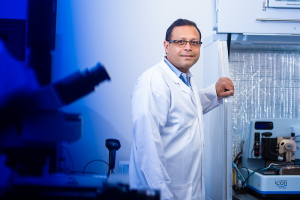The National Science Foundation (NSF) awarded a three-year grant to a UH Cullen College of Engineering research team led by Alamgir Karim, professor of chemical and biomolecular engineering. The team’s project, titled “Ordering of Block Copolymer Systems with Enhanced Molecular Interactions and Diffusional Dynamics,” received $399,718.
Karim is developing a revolutionary method to use solvents, instead of heat, to bond individual single-layer polymers into a multi-layered copolymer.
“The new technique will not only lower manufacturing costs, it also will give engineers the ability to customize copolymers for special uses,” said Karim, who is also director of the materials engineering program and director of the International Polymer and Soft Matter Center. “That factor is especially promising for high-tech markets.”
Copolymer products are all around us. Pick up a clear soda bottle, for example. Even after a close look you might assume it is made from a single material that was molded into shape. But it was more than likely made from single or multiple layers of polymer sheets that were melted inside a hot mold under pressurized gas to form a single or multi-layers of copolymer material, shaped into the bottle you hold in your hand.
Karim compares copolymer layers to the rock strata in the Grand Canyon, only copolymer layers are much, much thinner – maybe as tiny as one-millionth the width of a human hair, with the multilayers aligned with the new system he proposes, called direct immersion annealing (DIA).
Game-changing impact
In the marketplace, two benefits are expected with DIA technology, according to Karim and research assistant Ali Masud, a UH chemical engineering doctoral student. First, the energy saved with the new process would make manufacturing familiar products like soda bottles more cost effective.
Second – and this is the game changer – engineers will be able to tweak either the recipe or the process (or both) to produce a material that has the highly specific qualities that its end use requires. Product packaging could become more biodegradable or astronauts’ space suits more flexible. There may be infrared coatings that help keep buildings cool, car bumpers that are incredibly resilient, and food wrappings that defy more hot summer days than any food preservation system now in use.
In some cases, the highly refined copolymer materials might inspire advances in other fields. For example, they could help make bendable cell phones commercially viable, or perhaps bring improved batteries to the next generation of nano-devices.
Marketplace frontiers
“With this new technology, possibilities are wide open,” Karim said, adding his team’s job is to perfect the science. Once in the marketplace, the improved process will inspire industry scientists to become the new explorers by testing DIA-produced copolymers in applications not yet imagined in technology, industry, medicine, and commerce.
But that’s getting ahead of the story. For now, Karim and Masud are at work transforming the concept into reality and at the same time, maintaining its practicality. “The idea has to be faster, cheaper, better if it is to succeed in the marketplace,” Karim said.
As he now envisions the process, raw materials will be unrolled from supply spools and passed together through a bath of solvents; the finished copolymer material will be dried and rolled onto a single take-up spool. The large format can be more accommodating than the individual sheets produced by the current heat-based method.
“We must work out the new design systems. Nobody yet even knows the design rules,” Karim said. “So far, the system has not been tested.”
A lot of critical factors, including submersion time and controlling solvent evaporation, need to be determined. But the first challenge is to match the correct polymers with the appropriate solvents to produce the exact properties needed. Those demands vary widely according to use.
Many medical applications demand membranes that are absolutely impervious to specific components. “Safety depends on it,” Karim said. “In working with the AIDS virus, for example, not a single viral particle can be allowed to pass through, not a single one,” Karim said.
Automotive engineers protect lives in a very different way. Their ideal car bumper of the future will demand copolymers that have strength to endure hits, softness to cushion shock, resilience to return to original shape after impact (“self-healing” as in nature), and tolerance to stand extreme weather, season after season.
Such diversity of needs requires the Karim’s team to balance three basic types of solvents in the immersion mixture that, only half-joking, he refers to as The Good, The Bad and The Ugly.
“The ‘good’ solvents do the work,” Karim explained. They contain the chemistry that do the actual formation of the polymer layers.
The “bad” solvents do not actively contribute to the process, but they offer major value in simply staying put. By keeping the polymers coated, they help the good solvents stay in contact with the surfaces where the job of layering and bonding is done.
That leaves the “ugly” solvents, which take on the less exciting-sounding task of adjusting molecules, rearranging them into a logical, permanent order that resembles shingles on a roof. The phenomenon is referred to as directed self-assembly.
Reaching out
Karim and Masud will be joined later in their UH labs by aspiring science students from Yates High School near UH.
“That target for that is sometime in Spring 2020 semester, so the students may continue over the summer as a science project, if interested,” Karim said.
The goal is to stoke the high school students’ interest in research in soft materials science, a growing field. In addition, the opportunity would provide lab experience and enhance the students’ chance in getting into well-ranked colleges in STEM fields.
The NSF award period started last June and continues through May 2022.
